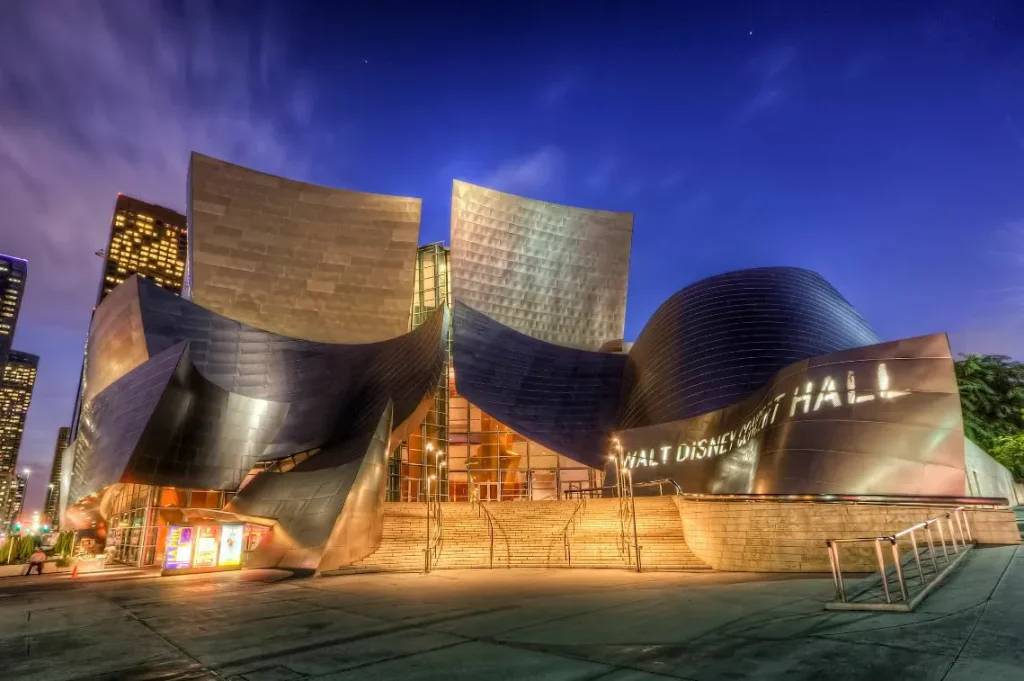The Walt Disney Concert Hall, an emblem of architectural brilliance and sustainability, stands as a testament to Los Angeles‘ commitment to innovative design.
Revered globally for its unique aesthetics and acoustics, this edifice also exemplifies the integration of sustainable practices in contemporary architecture.
Designed by Frank Gehry, a pioneer in deconstructivism, the concert hall’s striking form is not merely a whimsical expression; it embodies deep-rooted consideration for environmental efficiency.
This examination delves into dual aspects of the Walt Disney Concert Hall: its groundbreaking architectural design and its incorporation of sustainable features.
The study aims to provide a nuanced understanding of how these two elements intertwine within Gehry’s masterpiece.
Further exploration will serve to uncover how this iconic building has set new benchmarks in balancing aesthetic appeal with ecological responsibility – contributing meaningfully towards creating a sense of belonging within communities that hold sustainability dear.
Key Takeaways
– Walt Disney Concert Hall is a remarkable example of architectural brilliance and sustainability.
– The building sets new standards for balancing aesthetic appeal with ecological responsibility.
– It incorporates innovative sustainability features such as energy-efficient fixtures and rainwater harvesting systems.
– The concert hall challenges conventional notions about sustainability in architecture and provides valuable insights into designing with reverence towards nature.
Architectural Design and Innovation
The architectural design of the Walt Disney Concert Hall, characterized by its innovative use of curvilinear forms and cutting-edge acoustics technology, represents a significant advancement in sustainable building practices.
The concert hall, designed by renowned architect Frank Gehry, is distinguished by its fluid and dynamic exterior composed of shimmering stainless steel panels which reflect the vibrant urban landscape surrounding it. This aesthetic uniqueness not only contributes to the creation of a strong sense of place but also provides functional benefits such as improved thermal performance and natural ventilation.
Delving deeper into its structure reveals an acute attention to sustainability principles. The interior design prioritizes natural lighting with large windows that allow for daylight penetration while reducing artificial lighting needs during daytime operations. The use of energy-efficient fixtures further minimizes energy consumption, aligning with the broader commitment to sustainability. The materials used throughout the building were selected for their durability and low environmental impact; recycled materials were incorporated where possible, minimizing waste during construction.
The incorporation of state-of-the-art acoustic technology enhances this focus on sustainability by optimizing sound quality without relying on electronic amplification systems that consume high levels of electricity. Through thoughtful design strategies such as these, the Walt Disney Concert Hall simultaneously promotes cultural enrichment through music and responsible stewardship of resources – demonstrating that architectural innovation can be both aesthetically pleasing and environmentally conscious.
Sustainability Features
Unrivaled in its commitment to environmental responsibility, the Walt Disney Concert Hall integrates innovative sustainability features that are nothing short of revolutionary. Despite its futuristic and avant-garde design, this architectural marvel is deeply rooted in sustainable practices, demonstrating a profound respect for the environment and a foresight towards resilient city planning. Its design incorporates advanced technologies and building materials that not only reduce energy consumption but also enhance acoustic performance, delivering an ethereal experience that resonates with the audience on multiple levels.
The structure makes use of high-performance glass which allows natural light to permeate indoor spaces while minimizing heat gain thus reducing dependence on artificial lighting.
The exterior skin made from stainless steel reflects sunlight during the daytime, lowering cooling costs and carbon footprint.
A sophisticated HVAC system optimizes energy use by adapting to various conditions such as occupancy levels or outdoor temperature changes.
Rainwater harvesting systems have been installed to collect rainwater for landscape irrigation purposes thereby conserving water resources.
The Walt Disney Concert Hall embodies a harmonious blend of aesthetic prowess, acoustic excellence, and environmental responsibility in Central Los Angeles. Its myriad sustainable features serve as living testament to how modern architecture can be leveraged not only for artistic expression but also as an instrument for environmental stewardship.
This inspiring edifice challenges conventional notions about sustainability in architecture by demonstrating that even ground-breaking designs can be eco-friendly without compromising on functionality or aesthetics. It certainly provides valuable insights into how buildings of tomorrow can be designed with reverence towards Mother Nature while still fulfilling their intended purpose effectively.
Exploring The Broad’s Impressive Collection Of Contemporary Art
The Enduring Legacy Of The Hollywood Sign As A Global Symbol For Dreams And Stardom



